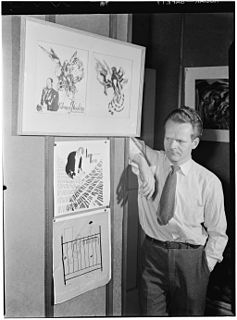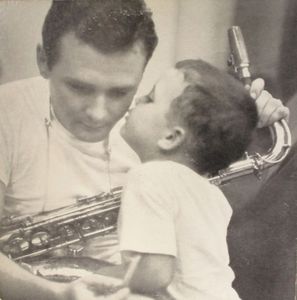
A clef is a musical symbol used to indicate the pitch of written notes. Placed on a stave, it indicates the name and pitch of the notes on one of the lines. This line serves as a reference point by which the names of the notes on any other line or space of the stave may be determined.

Jean-Baptiste "Illinois" Jacquet was an American jazz tenor saxophonist, best remembered for his solo on "Flying Home", critically recognized as the first R&B saxophone solo.

Barney Kessel was an American jazz guitarist born in Muskogee, Oklahoma. Noted in particular for his knowledge of chords and inversions and chord-based melodies, he was a member of many prominent jazz groups as well as a "first call" guitarist for studio, film, and television recording sessions. Kessel was a member of the group of session musicians informally known as the Wrecking Crew.
Paul Quinichette was an American jazz musician who played the tenor saxophone. He was known as the "Vice President" or "Vice Prez" for his uncanny emulation of the breathy style of Lester Young, known as "Prez". Young, who affectionately called everyone "Lady ****", called him "Lady Q". Quinichette was also capable of a gruffer style on his own.
Bass or Basses may refer to:
A debut or début is the first public appearance of a person or thing.

Joseph Edward Filippelli, known professionally as Flip Phillips, was an American jazz tenor saxophone and clarinet player. He is best remembered for his work with Norman Granz's Jazz at the Philharmonic concerts from 1946 to 1957. Phillips recorded an album for Verve when he was in his 80s. He performed in a variety of genres, including mainstream jazz, swing, and jump blues.
Joseph Dwight Newman was an American jazz trumpeter, composer, and educator, best known for his time with Count Basie.

David Stone Martin, born David Livingstone Martin was an American artist best known for his illustrations on jazz record albums.
Benny Powell was an American jazz trombonist. He played both standard (tenor) trombone and bass trombone.
Clef Records was an American jazz record label founded by Norman Granz in 1946. It became part of Verve Records, which Granz created in 1956. Clef recordings were, in the mid 1950s, licensed to Columbia (UK) who issued 78rpm discs with a special white label and the Clef logo.

Krupa and Rich is a 1956 studio album by jazz drummers Gene Krupa and Buddy Rich, released on Norman Granz' Clef Records. Krupa and Rich play on two different tracks each and play together only on "Bernie's Tune." Krupa and Rich would record again for Verve Records; their album Burnin' Beat was released in 1962.

Little Jazz is an album by American jazz trumpeter Roy Eldridge recorded in 1954 and originally released on the Clef label. "Little Jazz" was Roy Eldridge's nickname.
This is the complete discography of the main 12-inch (8000) series of LPs issued by Verve Records, a label founded in 1956 by producer Norman Granz in Los Angeles, California. Alongside new sessions Granz re-released many of the recordings of his earlier labels Clef and Norgran on Verve.
Ahmad Khatab Salim or Ahmad Kharab Salim was an American jazz composer, and arranger.

Basie Jazz is an album by pianist/bandleader Count Basie recorded in 1952 and released on the Clef label in 1954. Selections from this album were also released on the 1956 Clef LPs The Swinging Count! and Basie Rides Again!.

Groovin' with Jacquet is an album by American jazz saxophonist Illinois Jacquet, recorded in 1951 and late 1953 and released on the Clef label.

Dale's Wail is an album by American jazz trumpeter Roy Eldridge recorded in 1953 and originally released on the Clef label.

Stan Getz Plays is an album by saxophonist Stan Getz, recorded in 1952 and first released on the Norgran label in 1955. The album features tracks that were previously released on two 10-inch LPs on Clef Records.
This page is based on this
Wikipedia article Text is available under the
CC BY-SA 4.0 license; additional terms may apply.
Images, videos and audio are available under their respective licenses.










